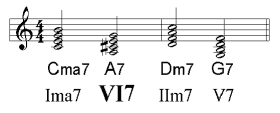

Perfect, imperfect, and half cadences are all formal cadences that can provide closure to a musical phrase, theme, or section. Standing on the dominant is an important marker of significant formal events in Classical-style music. When this post-cadential dominant pedal point extends into multiple measures, music theorists like to call it “standing on the dominant”. When either of these occurs, the initiating strong-beat cadential dominant is often a cadential six-four chord or a V chord with a 4–3 suspension. Half cadences frequently extend the strong-beat arrival of the D 5 ˆ cadential dominant, either onto a following weak beat, or into further measures of dominant pedal point. Instead, the D 5 ˆ is heard as the harmonic goal of the phrase and becomes more like a tentative partial closure.

One might think that this failure to reach both melodic and harmonic closure would give the music a sense of being interrupted before the D 5 ˆ can resolve. In a half cadence, most frequently the melody comes to rest on Re 2 ˆ over the cadential D 5 ˆ, but Ti 7 ˆ is also seen frequently, and 5 ˆ is also possible in some contexts. A cadence that ends on the cadential dominant is a half cadence or semicadence (HC).
#Dominant chord provides the anacrusis full
In this case, neither the melody nor the harmony achieve their full closure on Do 1 ˆ. Sometimes the strong-beat arrival of the cadential dominant is the phrase’s goal rather than arrival on a final tonic. Only use the label Imperfect Authentic Cadence (IAC) for cadences lacking only in full melodic closure to Do ( 1 ˆ). We shall discuss cadences that subvert harmonic closure of the perfect cadence later. Our definition of imperfect cadence is restricted to melodic disruptions of the perfect cadence. Older cadence taxonomies consider any dominant to tonic progression other than the perfect cadence as an imperfect authentic cadence. The imperfect cadence must have complete closure in every other regard, however, including both a D 5 ˆ cadential dominant and a T 1 ˆ root-position final tonic.

Most commonly in an imperfect cadence, the melody comes to rest on Mi ( 3 ˆ). If only the melodic closure is lacking, it is an imperfect cadence. The Imperfect CadenceĪll other cadence types lack some degree of closure when compared with the perfect cadence. We shall label perfect cadences using their conventional name: Perfect Authentic Cadence, or PAC. When this occurs as the resolution to the cadential dominant, it is a perfect cadence. The greatest possible degree of closure occurs when the melody comes to rest on Do ( 1 ˆ) above a root position I chord (T 1 ˆ). We can identify the specific cadence type by examining the degree of closure achieved in the melody and the harmony. Note that only a D 5 ˆ can function as a cadential dominant, while D 7 ˆ and D 2 ˆ cannot. The cadential dominant can have weaker metrical placement than the final tonic’s (if a final tonic exists), but it must have metrical strength similar to or greater than the structural subdominant or initial tonic that immediately precedes it. The third stage is the cadential dominant, a D 5 ˆ on a strong beat. The second stage contains one or more structural subdominant chords (also known as pre-dominants, the most common being ii 6). (If the phrase begins with an anacrusis or pickup, then the initial tonic can occur on the weak-beat pickup.) The first stage is an initial tonic: a I 6 (T 3 ˆ), or sometimes a substitute harmony (any T 1 ˆ, T 3 ˆ, or T 6 ˆ), usually occuring on a strong beat. Analyzing Cadential ProgressionsĬadential progressions have three stages, although sometimes either stage one or stage two is missing. This D 5 ˆ is called the cadential dominant.

The single element shared by all variations of the cadential harmonic formula is a D 5 ˆ chord occuring in a metrically strong position. The conventional harmonic formula that leads to the cadence is called a cadential progression. A cadence is a moment of melodic and harmonic closure created by the use of a conventional harmonic formula together with a melodic resting point.


 0 kommentar(er)
0 kommentar(er)
